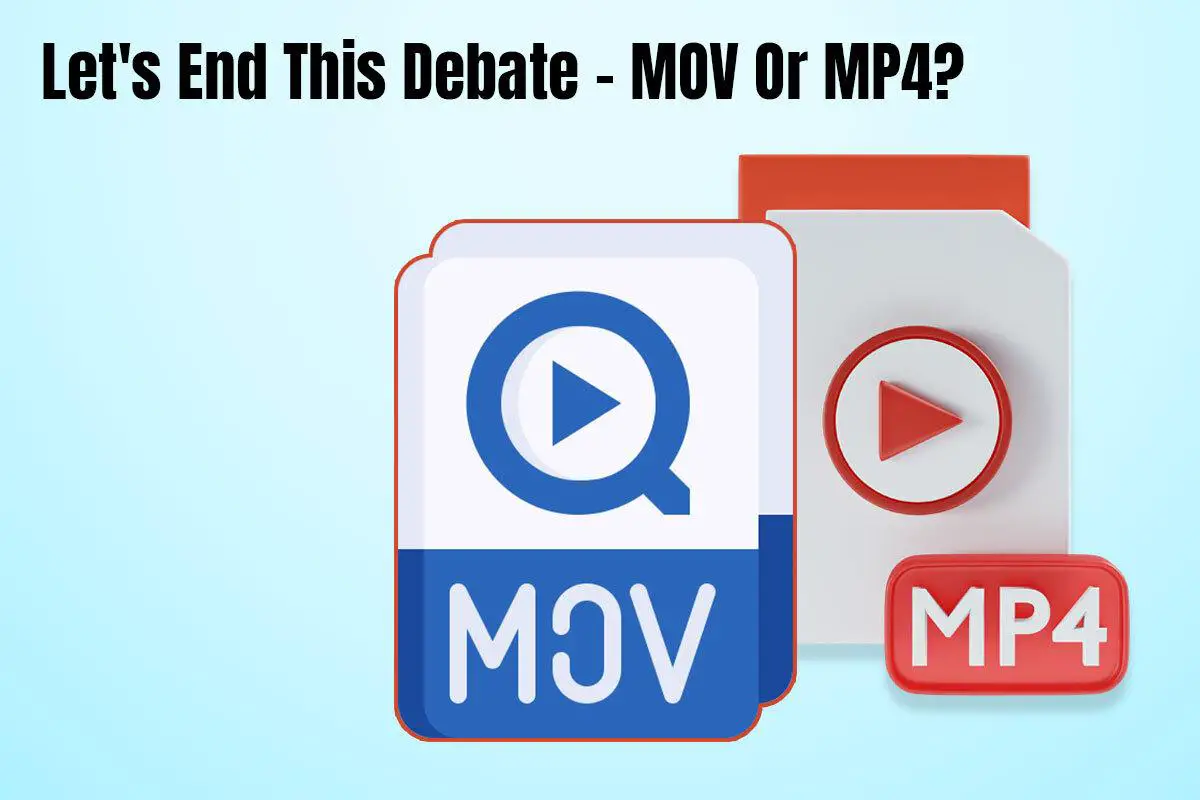In the dynamic realm of digital video, two contenders, MOV and MP4, often find themselves in the spotlight, triggering spirited debates among users. To unravel the mystique surrounding these formats, let’s embark on a journey through their fundamental aspects.
MOV Format Unveiled
First in the spotlight is MOV, a video format with roots firmly planted in the orchard of Apple Inc. The acronym stands for QuickTime Movie, and its close association with Apple’s QuickTime multimedia framework makes it a cornerstone within the Apple ecosystem. Users of Mac computers, iPhones, and iPads find MOV to be a familiar companion in their multimedia endeavors.
Although MOV files are of high quality, they tend to be larger in size and might be supported by all players. If you need to upload the file online, the platform might not support MOV. Owing to these challenges, many users prefer converting mov to mp4 macos to ensure seamless compatibility across platforms and video players. You can use iMovie to easily change MOV to MP4 while retaining the original file.
The MP4 Format Breakdown
On the flip side, we have MP4, formally known as MPEG-4 Part 14. This versatile video format boasts a universal appeal, breaking free from any exclusive affiliations. Unlike MOV’s allegiance to Apple, MP4 spreads its wings across a diverse range of devices and operating systems, earning its stripes as a format for the masses.
Compatibility: Where Do MOV and MP4 Stand?
When it comes to compatibility on MacOS, MOV gracefully syncs with Apple devices and applications. However, its charm dwindles when attempting to bridge the gap across various platforms. MacOS users and certain third-party applications may not dance as fluidly with MOV files as they do with their MP4 counterparts.
MP4, the universal language of video, embraces a broader spectrum of devices and operating systems on MacOS as well. Whether you’re navigating the MacOS landscape, wielding an Android device, or lounging in front of a smart TV, MP4’s playback prowess requires no additional software, offering a hassle-free experience.
File Size Matters: A Comparison
File size, a pivotal consideration in the format arena, tips the scales between MOV and MP4. MOV files, by nature, tend to be larger, a characteristic that might raise eyebrows, especially for users grappling with limited storage or sluggish internet connections.
Contrastingly, MP4 stands as the embodiment of efficiency in compression algorithms. It crafts smaller file sizes without compromising significantly on video quality, a trait that positions MP4 as the go-to choice for online streaming, video sharing, and scenarios where optimizing file size is paramount.
Quality Check: Are There Differences in Video Quality?
As we peer through the lens of video quality, the dichotomy between MOV and MP4 comes into focus. Both formats pledge allegiance to high-quality video, yet some users champion MOV, claiming a subtle advantage in preserving the original video quality. However, this advantage, akin to a whisper in a crowded room, may not register with the average viewer, rendering the debate on this aspect inherently subjective.
MP4, an undisputed heavyweight in the digital landscape, proudly flaunts excellent video quality. Its popularity across diverse platforms serves as a testament to its prowess, standing tall whether you’re shooting videos on a humble smartphone or wielding the artillery of professional cameras.
The Editing Realm: MOV vs. MP4 in Post-Production
MOV Editing Capabilities
Within the confines of the Apple ecosystem, MOV files shine brightly. The likes of Final Cut Pro and iMovie seamlessly embrace MOV, offering a user-friendly editing experience enriched with advanced features. For individuals who have a strong connection to the Apple ecosystem, MOV turns out to be more than just a format; it becomes a component of an extensive video editing ecosystem.
MP4 Editing Flexibility
Yet, MP4 refuses to take a backseat in the editing arena. It works with many tools, including popular software like Sony Vegas and Adobe Premiere Pro. This versatility positions MP4 as the go-to choice for content creators navigating diverse platforms. The flexibility to edit MP4 files across different applications adds an extra layer of convenience to the video creation process.
Streaming and Online Platforms: Which Format Prevails?
MOV and Streaming Platforms
When it comes to streaming, MOV faces a bit of a hurdle in terms of universal acceptance. Its stronghold is evident in Apple-centric platforms like Apple TV+, but its reach doesn’t extend seamlessly across all online streaming avenues. The exclusive nature of MOV aligns well with Apple’s dominance but may pose challenges for creators aiming to cast a wider net.
MP4 Dominance in Online Spaces
Contrastingly, MP4 stands tall as the undisputed champion in the online realm. Platforms like YouTube, Vimeo, and various social media channels embrace MP4, making it the preferred choice for content creators aspiring for maximum visibility. MP4’s efficient compression techniques, coupled with its broad compatibility, ensure that videos smoothly traverse diverse devices and varying internet speeds.
The Technical Side: Codec and Compression
MOV Codec and Compression
Beginning with MOV, it dances gracefully with the H.264 codec, a maestro in delivering excellent compression without forfeiting video quality. Adding a touch of finesse, Apple’s ProRes codec becomes a companion in arms, a popular choice that elevates MOV to the realm of high-quality video production fit for the grand stage of professional editing and broadcasting.
MP4 Codec and Compression
On the other side of the spectrum, MP4 steps onto the stage, carrying the H.264 codec as its standard, setting the tone for online streaming and digital distribution. Here, a delicate equilibrium emerges between file size and video quality, a dynamic that ensures a seamless streaming experience. Yet, MP4 goes a step further, embracing the avant-garde with support for newer codecs like H.265 (HEVC), unlocking the door to even more efficient compression for those craving higher-resolution videos.
Device-Specific Considerations
As we pivot to consider the device-specific dance of MOV and MP4, a tale unfolds.
If your world revolves around Apple devices, the choice of MOV becomes a seamless extension of your multimedia journey. From iPhones and iPads to MacBooks and iMacs, MOV files have become an integral part of the Apple ecosystem, weaving a cohesive tapestry of multimedia experiences.
Contrastingly, MP4 emerges as the universal troubadour, serenading across a myriad of devices. Its cross-platform compatibility extends beyond the boundaries of Apple’s walled garden, ensuring a harmonious playback whether you find yourself amidst the Windows landscape, wielding an Android smartphone, or basking in the ambiance of a Linux machine. MP4 stands tall, a reliable choice that bridges hardware preferences without stumbling into compatibility concerns.
Future Trends: What Lies Ahead?
As we cast our gaze toward the horizon, the unfolding tale of digital video holds promises of new formats and codecs. The landscape is dynamic and ever-shifting with technological innovations. Keeping a vigilant eye on industry developments becomes paramount, as these shifts may influence the way we capture, edit, and share our videos. MOV and MP4, stalwarts in the digital dance, have proven their resilience, adapting to the evolving standards. Staying informed becomes the compass guiding us through the currents of the next wave of advancements, where the future promises to unfold new chapters in the ever-growing saga of digital video.
In conclusion, the discussion around MOV vs. MP4 in digital video shows a complex environment. MOV, which is part of the Apple ecosystem, is a great editor but has issues with compatibility and higher file sizes. The ubiquitous MP4 format provides effective compression, wide interoperability, and domination in online environments. While MP4’s versatility makes it a dependable option, MOV may have a subjective advantage when it comes to maintaining video quality. It’s critical to keep up with industry advancements as the digital video market changes. Although MP4 and MOV, as industry mainstays, have shown their durability, new developments in the constantly expanding field of digital video are anticipated.





